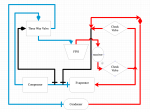I live in Tampa, FL and had the hotspot for about 6 months. We did have compressor going bad during that time, so the FPH probably was not working at optimal efficiency. The compressor was not maintaining constant pressure.
After we had the compressor replaced....UNDER WARRANTY (House is 3 years old, just had to pay for labor). The FPH dumps a ton of heat into the pool throughout the day.
Yes there are temperature set points, which can be modified up or down.
Yes I would install it again, but with caution:
1. You need an expert installer, possibly commercial experience. One that understands that you will call them a few times after installation for questions, assistance, issues, etc. It tool a few questions back and forth between HotSpot, me, and the installer to get it dialed in.
2. You need to monitor the hotspot and the installation to ensure its dialed in and working properly. After the compressor was replaced, Hotspot is on autopilot.
3. Collect data before you install and after. Every location and environment is different. for example, the orientation of your pool (ie north, east, west, south), amount of shade, screen or not, location (ie. FL versus Colorado cannot be compared) etc.. So everyone's results will obviously vary. For me in Tampa FL, I wanted to not only make my water comforatable during the swimming season (ie +4-5 degrees), but also wanted to extend swimming season to almost year round. I think now that its dialed in I will definitely almost get year round swimming.
4. I have heavy Hayward automation. So we added a independent pump for the HOTSPOT. I've seen some, that just have their primary pump run 24/7 on low speed, but I don't like that idea for various reasons (ie if you have a heated spa...the temp will exceed safety margin for cooling Freon, running the pump 24/7, etc). I didn't like the way it was plumed to the same outflow pipping to the pool, bypassing the filter and working against my primary pump when on. So I took a Saturday installed a separate filter for the FPH pool pump we installed and also isolated the outflow return to the ones on the floor. The extra filter was great idea, as I get extra filtration while the FPH pool pump is running This great, the primary pump does not have another pump creating head pressure, I visually see the water ripples from the bottom pipe...telling me the FPH is on, it also concentrates the heat better (higher temp on the outflow the better, the other way diluted the temperature), and now my automation/spa has no issues (we could not use the FPH during spa mode, so we either turned off the A/C inside or turned off the FPH controller....no we don't need to do that).
5. Ensure you install a Water FLOW cutoff valve. It does not come with the HOTSPOT FPH but the controller does have a spot for the cutoff wires. This will ensure that if it does not sense water, the controller will default to AIR COOL on the condenser. This would essentially stop any of the overheat complaints from the other post. I learned this from oneamaruluv...he is also here in Tampa, and we worked together to get out systems dialed in....by sharing in lessons learned.
- - - Updated - - -
All my neighbors love our constant water temperature in our pool water, and are looking into getting a HOTSPOT FPH. Especially, since they had issues with their previous solar installation due to roof leak.
I will tell you that its comparable to solar heat. My other neighbor has solar heat, and he an I are always comparing temps. His pool faces south (all day heat) and mine faces north (and shade from house). So I still think I come out ahead, as he has an advantage with all day heat from the sun.
Once we get into the cooler months, we will determine which works better between the two. Again our location is Tampa, Fl....which is crucial to understand, that there are several variables to consider....not each installation or application is the same.


